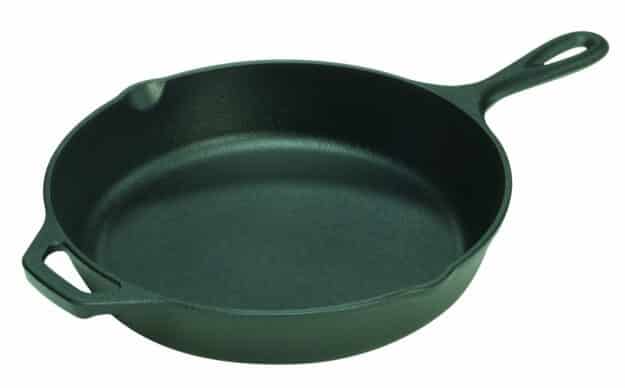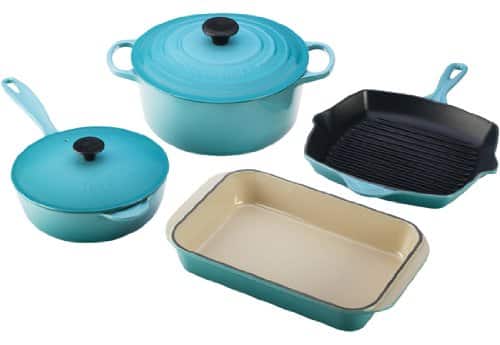Looking for the safest cooking pans? You have come to the right place.
I’ve done some research to help you sort through fact and fiction so you can brush up on your knowledge to find the healthiest and safest cookware to use for your family meals.
I get tons of emails and comments about how to choose the safest cooking pans.
It’s a confusing topic, and there’s a lot of conflicting information out there. Not to mention every. single. cookware company claims to have the latest, greatest, safest nonstick cookware on the planet.
So if your head is buzzing like mine was when I started researching safe cookware, then read on.
I’m sharing the basics of non-toxic cookware, plus my personal favorites and what I’m comfortable using every day.
Is safe cookware really important?
Sure, we take time to choose healthy good and avoid unnecessary additives when we can, but these aren’t the only toxins that can be present in our food. Our cookware may also be contributing to our toxic state.
Think about it: you want to cook with your pots and pans, but you don’t want to eat them!
And unfortunately, a lot of modern cookware leaches toxins right into the food we’re eating.
So that’s not just an omelet you’re tasting–you could be munching on some not so nourishing aluminum (yuck, right?). The leaching issue is a big one, believe me.
The topic of safe cookware is somewhat controversial.
For instance, some say stainless steel is safe, while others warn that acidic foods may cause toxic nickel, cobalt, and chromium to leach into your food (read more about that in this study).
You might like to check out: Best Non Toxic Air Fryers
Here’s how I look at it:
We may not have all the answers when it comes to cookware, but we can avoid the worst and start making healthier choices with the information we have now. And that’s definitely a step in a positive direction!
Here is some of the information I’ve gathered so far:
AVOID THESE COOKWARE MATERIALS
Aluminum.
This is a highly toxic metal, linked to Alzheimer’s and dementia among other conditions. (Read about the toxic effects of aluminum here.)
Aluminum conducts heat quickly, which is why it’s often used in cookware.
The problem?
Aluminum also leaches very easily, especially when heated or exposed to acidic foods (tomato soup, anyone?).
Avoid cheap cookware made of straight-up aluminum.
Some cookware uses an aluminum core that is encased in a safer cooking material. These are generally acceptable and safe options, as long as the surface is strong and undamaged (so no aluminum actually comes in contact with your food).
This sums it up:
You don’t want your food touching aluminum, especially if it’s heated.
Teflon/PTFE Nonstick Cookware Surfaces.
This is one of the most common types of cookware, but Teflon and some polytetrafluoroethylene (PTFE) nonstick surfaces can release toxic fumes into the air when overheated.
How often have you accidentally left a pan too long on the stove? I hate to admit, it happens sometimes at my house.
Or maybe there’s someone in your house (I won’t name names) who thinks high is a permanent setting on the stove.
Teflon just can’t take the heat. And that’s not the only problem with this nonstick surface.
Teflon/PTFE scratches easily if you’re not careful (metal utensils are a huge no-no with Teflon), so flecks of nonstick material can mix in unnoticed with your food (um, ew?).
And then once the surface scratches, your food is exposed to the metal underneath – most likely aluminum (and you know what that means).
So, PTFE nonstick cookware is a definite no-no. (There’s a great article about the problems with Teflon here.)
SAFER COOKWARE OPTIONS
Stainless Steel Cookware.
Even though there are small concerns with stainless steel cookware, it’s still a much better choice than aluminum or PTFE nonstick cookware.
It’s also in a somewhat affordable price range, so it’s easier to make the switch without going broke.
Here’s one downside:
Stainless steel is definitely not nonstick, so keep that in mind when using it so your eggs don’t glue themselves to the pan (true story). Using a good bit of oil, butter or other fat in the pan can definitely help, but sometimes that’s just not reasonable with every recipe.
The other downside is that quality stainless steel is stabilized with both chromium and nickel.
This keeps your stainless steel from rusting and makes it stronger. However, some research shows that if you cook acidic foods for long periods of time in your stainless steel cookware, it can potentially leach chromium and nickel into your food.
That’s why it’s best to use stainless steel cookware with non-acidic dishes only.
I would caution against using stainless steel for acidic dishes, especially those that need to be slow-cooked for longer periods of time (such as a tomato-based sauce that needs to simmer for hours).
I personally use several stainless steel pots and pans, mostly for boiling pasta, cooking rice, and simmering non-acidic soups and stews. I’ve only tried a few brands, but this is my favorite stainless steel cookware so far.
It’s just the right weight (not too heavy, not too light), and very sturdy. It’s put up with a lot and is still going strong. Plus, the lids have little steam vents that prevent my rice from boiling over!
Anodized Aluminum Cookware.
If you are looking for safe nonstick pans, anodized aluminum is probably your safest bet.
While it is made of aluminum, anodized aluminum cookware has been electrochemically anodized to make a more stable cooking surface. As long as it’s in good shape, this may be a safer option that’s user-friendly as well.
Plus, anodized aluminum is both nonstick and scratch-resistant. This is a huge bonus in my book. You still have to be somewhat careful with the cooking surface to avoid scratching it, but it’s nowhere near as damage-prone as Teflon.
When purchasing anodized aluminum cookware, be sure that the actual cooking surface is made of anodized aluminum.
Some brands will only have anodized aluminum on the outer surfaces, while the cooking surface is a nonstick PTFE material like Teflon.
Anodized aluminum is not the cheapest cookware on the market, but it can be purchased at a mid-range cost. I personally have faired well with this anodized cookware set.
I’m reasonably careful with my set and never use metal utensils on it, but I still use the heck out of it and wash it in the dishwasher, too.
It’s lasted more than a year and has held up very well. This may not be the most “natural” option, but I’m okay with the compromise.
HEALTHIEST, SAFEST COOKWARE OPTIONS
Ceramic.
This old-fashioned ceramic cookware is one of the safer kinds.
There’s also some kind of nostalgic enjoyment in using ceramic cookware. Things just look nourishing when served up in ceramic.
One problem with ceramic:
If the ceramic is produced by individuals or made in a foreign country it could very well contain lead in the glaze. Larger, domestic producers would be the safer bet.
There are a lot of brands claiming to have amazing nonstick ceramic cookware, but I’ve tried a few ceramic frying pans, and none of them have lived up to the hype so far (and the same goes for the supposed “granite” frying pans, etc.).
They aren’t truly nonstick and the surface often damages easily.
 Cast-Iron Cookware.
Cast-Iron Cookware.
My personal favorite cooking pan is my Lodge cast iron pan.
Another old-fashioned favorite, cast iron cookware is probably one of the healthiest cooking pans available. It can also be pretty nonstick if seasoned properly and if you use a little fat/oil in the pan when you cook.
What is Seasoning?
- Seasoning requires a little extra work (typically coating with oil and baking at high heat for about an hour; your cookware should come with detailed instructions).
- My secret to seasoning is to lightly coat my pan with coconut oil, then heat at 500 degrees F for one hour.
- The first time I get a pan, I repeat this process several times in a row.
- After using the pan, I scrub it out with hot water, then dry it off.
- Then I coat the inside with oil again and heat it on medium-high for a few minutes.
- My pan stays totally nonstick this way! (As long as I use a wee bit of oil or butter when I cook my eggs.)
Cast iron is also pretty heavy (maybe cooking with it could be considered a good workout?). But overall I say no kitchen is complete without at least one or two cast iron pieces. I know it’s my favorite and I wouldn’t do without it.
Another bonus to cast iron?
It’s very versatile: it can go straight from the stovetop and into the oven. Trust me, you can make some awesome cornbread in one of these.
Enameled Cast Iron.
This is even a step up from regular cast iron because the enamel surface is easy to cook with and clean (dishwasher-safe). You also don’t have to worry about seasoning enameled cast iron cookware. I wouldn’t quite call it nonstick though, so keep that in mind.
I have the beautiful Le Creuset 6-qt pot in the lovely Caribbean Blue and I adore it. I use it to cook stock and more acidic dishes that I’d rather not put in a stainless steel pot.
The downside:
It generally comes with a hefty price tag, but if you have the cash to spend, it would probably make a worthy investment.
The pricey Le Creuset brand even offers an impressive 99-year warranty! So even though the cost is generous upfront, you’ll get a lifetime use out of your cookware, and you’ll know it’s safe. And, I have to say, it’s downright gorgeous.
Transitioning to Healthiest Cooking Pans
Of course, it’s not easy to shell out the cash for the healthiest cooking pans, especially when you’re trying to afford better quality food.
But it’s definitely a good investment for your health.
My suggestion?
Save up for a good set, or replace one piece at a time.
If your current cookware is in good shape, you can probably squeak by if you’re being careful with it and replacing a little at a time.
However, if you’ve got scratch-and-dent Teflon you might want to consider taking the plunge and replacing it with something safer.
What kind of cookware do you use? What do you think is safe cookware? I’d love to hear from you in the comments!
More Healthy Living Posts from Elizabeth:
- How to Clean an Oven with Natural Oven Cleaner
- 35 Natural DIY Cleaning Recipes for a Naturally Clean Home
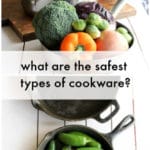
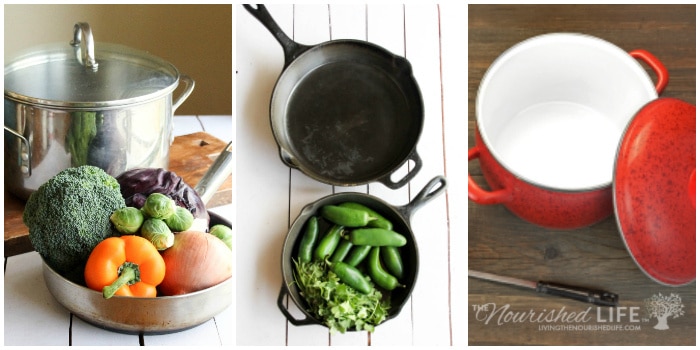
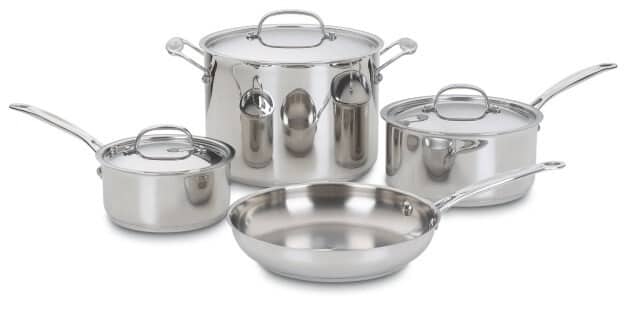
 Cast-Iron Cookware.
Cast-Iron Cookware.